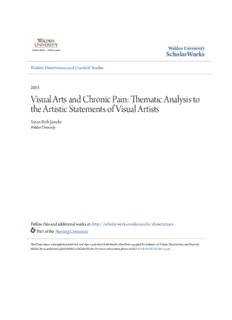
Visual Arts and Chronic Pain: Thematic Analysis to the Artistic Statements of Visual Artists PDF
Preview Visual Arts and Chronic Pain: Thematic Analysis to the Artistic Statements of Visual Artists
Walden University ScholarWorks Walden Dissertations and Doctoral Studies Walden Dissertations and Doctoral Studies Collection 2015 Visual Arts and Chronic Pain: Thematic Analysis to the Artistic Statements of Visual Artists Susan Beth Janicke Walden University Follow this and additional works at:https://scholarworks.waldenu.edu/dissertations Part of theNursing Commons This Dissertation is brought to you for free and open access by the Walden Dissertations and Doctoral Studies Collection at ScholarWorks. It has been accepted for inclusion in Walden Dissertations and Doctoral Studies by an authorized administrator of ScholarWorks. For more information, please [email protected]. Walden University College of Health Sciences This is to certify that the doctoral study by Susan Janicke has been found to be complete and satisfactory in all respects, and that any and all revisions required by the review committee have been made. Review Committee Dr. Mary Verklan, Committee Chairperson, Health Services Faculty Dr. Riyad Naser, Committee Member, Health Services Faculty Dr. Joan Moon, University Reviewer, Health Services Faculty Chief Academic Officer Eric Riedel, Ph.D. Walden University 2015 Abstract Visual Arts and Chronic Pain: Thematic Analysis to the Artistic Statements of Visual Artists by Susan Beth Janicke MS, Graceland University, 2006 BS, Graceland University, 2006 Project Submitted in Partial Fulfillment of the Requirements for the Degree of Doctor of Nursing Practice Walden University November 2015 Abstract The relief of pain is an essential element of nursing practice. Nursing has begun to successfully use art to assess and reduce pain among hospitalized children, surgical patients, and oncology patients. Structured art projects have been used to provide distraction from pain and patient drawings have allowed nurses to assess pain. This project employed grounded theory and thematic analysis to uncover significant concepts in the artists’ statements. The Roy adaptation model and Saunders’ total pain theory provided the project theoretical framework. The artistic statements and the art of chronic pain patients were examined using thematic analysis to identify recurrent themes. This project explored the insights to chronic pain in the adult patient as evidenced in the posted work. The project also considered how the content of the posted artistic statements informed individual nursing practice and facilitated the reduction of pain in the adult patient suffering from chronic pain. Emergent concepts were used to develop artistic nursing interventions. Suggested modification of nursing practice included drawing as a tool in pain assessment, exploring the meaning of color choices, encouraging mask making, providing distraction, and using art to identify spiritual distress. The proposed nursing actions will allow more effective communication of pain, provide meaningful distraction, intervene in spiritual distress, and encourage creation of an artistic product. Expected outcomes include more effective pain control, greater patient autonomy, and reduced healthcare costs. The application of this new knowledge and skill will make a difference in the lives of chronic pain patients and will therefore promote positive social change. Visual Arts and Chronic Pain: Thematic Analysis to the Artistic Statements of Visual Artists by Susan Beth Janicke MS, Graceland University, 2006 BS, Graceland University, 2006 Project Submitted in Partial Fulfillment of the Requirements for the Degree of Doctor of Nursing Practice Walden University November 2015 Dedication This project is dedicated to the artists of PainExhibit. They have demonstrated courage in adversity and a willingness to help others with chronic pain. Acknowledgments I would like to acknowledge the sage guidance of Dr. Mary Therese Verklan, project chair. Her unfailingly positive feedback made this project possible. A special thanks to Dr. Riyad Naser and Dr. Joan Moon, who offered necessary and timely critiques. I would like to thank Dr. Nancy Moss, Mr. Robert Brandt, and Ms. Shannon Mikko for their advocacy at a sensitive point of the doctoral program. I offer thanks to the members of the interdisciplinary team: Ms. Angela Erickson, Mr. Patrick Foley, and Dr. Richard Hegal. Finally, a personal thanks to editor Robley C. Henry for review of first drafts and providing many personal supports. Table of Contents Section 1: Nature of the Project ...........................................................................................1 Introduction ....................................................................................................................1 Background ....................................................................................................................2 Problem Statement .........................................................................................................3 Purpose Statement ..........................................................................................................3 Framework .....................................................................................................................4 Nature of the Project ......................................................................................................4 Project Questions ...........................................................................................................5 Evidence-Based Significance of the Project ..................................................................5 Implications for Social Change in Practice ....................................................................6 Definitions of Terms ......................................................................................................8 Assumptions ...................................................................................................................8 Scope and Delimitations ................................................................................................9 Limitations .....................................................................................................................9 Significance/Relevance to Practice ..............................................................................10 Summary ......................................................................................................................11 Section 2: Review of Literature and Theoretical and Conceptual Framework ..................12 Introduction ..................................................................................................................12 Search Procedure .........................................................................................................12 Specific Literature ........................................................................................................13 General Literature ........................................................................................................15 i The Healing Environment ..................................................................................... 16 When Art Does Not Work .................................................................................... 17 The Written Word as Analogue ............................................................................ 17 Theoretical Basis ..........................................................................................................18 Summary ......................................................................................................................20 Section 3: Methodology .....................................................................................................22 Introduction ..................................................................................................................22 Project Designs/Methods .............................................................................................22 Population and Sampling .............................................................................................23 Data Collection ............................................................................................................23 Data Analysis ...............................................................................................................25 Human Subjects ...........................................................................................................27 Project Evaluation Plan ................................................................................................27 Summary ......................................................................................................................28 Section 4: Findings, Discussion, and Implications ............................................................29 Introduction ..................................................................................................................29 Summary of the Findings .............................................................................................29 View or Perspective of Self .................................................................................. 29 Concealment of Pain ............................................................................................. 30 Communicating the Pain ....................................................................................... 31 The Isolating Nature of Pain ................................................................................. 32 Making Sense of or Finding Meaning in the Pain ................................................ 33 ii Better With Art ..................................................................................................... 34 Expressing Hope ................................................................................................... 34 The Use of Color ................................................................................................... 35 Spiritual Distress ................................................................................................... 36 Discussion of the Findings in the Context of Literature and Frameworks ..................36 View or Perspective of Self .................................................................................. 37 Concealment of Pain ............................................................................................. 38 Communicating the Pain ....................................................................................... 38 The Isolating Nature of Pain ................................................................................. 40 Making Sense of or Finding Meaning in the Pain ................................................ 40 Better With Art ..................................................................................................... 41 Expressing Hope ................................................................................................... 42 The Use of Color ................................................................................................... 42 Spiritual Distress ................................................................................................... 43 Implications..................................................................................................................43 Drawing as a Tool in Pain Assessment ................................................................. 43 Exploring the Meaning of Color for the Patient ................................................... 44 Encourage Self-Exploration in Mask-Making ...................................................... 45 Providing Meaningful Distraction ........................................................................ 46 Producing a Product .............................................................................................. 47 Using Art to Identify Spiritual Distress ................................................................ 48 Encouraging Hope ................................................................................................ 49 iii
Description: